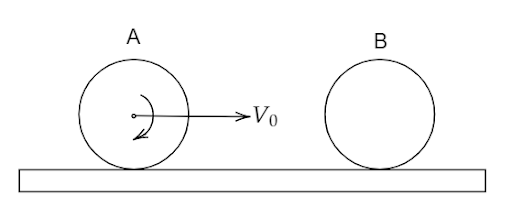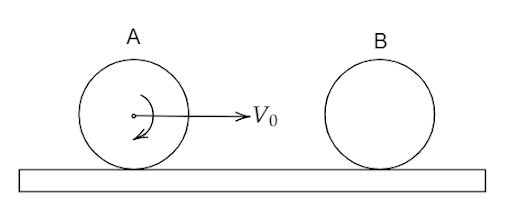Answer
77.7k+ views
Hint:Before we start addressing the problem, we need to know about the translational kinetic energy. The energy that is possessed by a body or object due to its velocity in one direction is referred to as translational kinetic energy. Let’s see how it acts on the object.
Formula Used:
To find the kinetic energy we have,
\[K.E = \dfrac{1}{2}m{v^2}\]
Where, m is mass of the sphere and v is velocity of the sphere.
Complete step by step solution:

Image: A hollow smooth uniform (A) and smooth solid cylinder(B)
Consider a hollow smooth uniform sphere A of mass m which rolls without sliding on a smooth horizontal surface. when the head-on collision happens with another stationary smooth solid sphere B of the same mass m and same radius.
In a head-on collision with an equal mass, the velocity gets exchanged after the collision. That is after the collision if you see, the A will have zero velocity and, B will have velocity \[{v_0}\]. Before the collision sphere A was moving with \[{v_0}\], so after the collision \[{v_A} = 0\] and \[{v_B} = {v_0}\].
Now if we talk about rotational motion sphere A will have the same rotational motion as it has earlier i.e., earlier it had zero velocity but after the collision, it had a velocity of \[\omega \]. Now to find the kinetic energy of sphere B as that of sphere A is given using equation (1) and here the K.E of A is due to rotational motion and the K.E of A is due to translational motion so,
\[{\left( {K.E} \right)_B} = \dfrac{1}{2}m{v^2}\]…………… (1)
\[\Rightarrow{\left( {K.E} \right)_A} = \dfrac{1}{2}I{\omega ^2}\]
\[ \Rightarrow {\left( {K.E} \right)_A} = \dfrac{1}{2} \times \dfrac{2}{3}m{R^2} \times {\left( {\dfrac{v}{R}} \right)^2}\]
\[ \Rightarrow {\left( {K.E} \right)_A} = \dfrac{1}{3}m{v^2}\]…………..(2)
Now, divide
\[\dfrac{{{{\left( {K.E} \right)}_B}}}{{{{\left( {K.E} \right)}_A}}} = \dfrac{{\dfrac{1}{2}m{v^2}}}{{\dfrac{1}{3}m{v^2}}}\]
\[\Rightarrow \dfrac{{{{\left( {K.E} \right)}_B}}}{{{{\left( {K.E} \right)}_A}}} = \dfrac{3}{2}\]
\[\therefore \dfrac{{{{\left( {K.E} \right)}_B}}}{{{{\left( {K.E} \right)}_A}}} = 3:2\]
Therefore, the ratio of the kinetic energy of B to that of A just after the collision is 3:2.
Hence, Option C is the correct answer
Note:There are two types of kinetic energy that is translational kinetic energy and rotational kinetic energy. Here when the head-on collision occurs between two spheres both translational and rotational kinetic energy will exist.
Formula Used:
To find the kinetic energy we have,
\[K.E = \dfrac{1}{2}m{v^2}\]
Where, m is mass of the sphere and v is velocity of the sphere.
Complete step by step solution:

Image: A hollow smooth uniform (A) and smooth solid cylinder(B)
Consider a hollow smooth uniform sphere A of mass m which rolls without sliding on a smooth horizontal surface. when the head-on collision happens with another stationary smooth solid sphere B of the same mass m and same radius.
In a head-on collision with an equal mass, the velocity gets exchanged after the collision. That is after the collision if you see, the A will have zero velocity and, B will have velocity \[{v_0}\]. Before the collision sphere A was moving with \[{v_0}\], so after the collision \[{v_A} = 0\] and \[{v_B} = {v_0}\].
Now if we talk about rotational motion sphere A will have the same rotational motion as it has earlier i.e., earlier it had zero velocity but after the collision, it had a velocity of \[\omega \]. Now to find the kinetic energy of sphere B as that of sphere A is given using equation (1) and here the K.E of A is due to rotational motion and the K.E of A is due to translational motion so,
\[{\left( {K.E} \right)_B} = \dfrac{1}{2}m{v^2}\]…………… (1)
\[\Rightarrow{\left( {K.E} \right)_A} = \dfrac{1}{2}I{\omega ^2}\]
\[ \Rightarrow {\left( {K.E} \right)_A} = \dfrac{1}{2} \times \dfrac{2}{3}m{R^2} \times {\left( {\dfrac{v}{R}} \right)^2}\]
\[ \Rightarrow {\left( {K.E} \right)_A} = \dfrac{1}{3}m{v^2}\]…………..(2)
Now, divide
\[\dfrac{{{{\left( {K.E} \right)}_B}}}{{{{\left( {K.E} \right)}_A}}} = \dfrac{{\dfrac{1}{2}m{v^2}}}{{\dfrac{1}{3}m{v^2}}}\]
\[\Rightarrow \dfrac{{{{\left( {K.E} \right)}_B}}}{{{{\left( {K.E} \right)}_A}}} = \dfrac{3}{2}\]
\[\therefore \dfrac{{{{\left( {K.E} \right)}_B}}}{{{{\left( {K.E} \right)}_A}}} = 3:2\]
Therefore, the ratio of the kinetic energy of B to that of A just after the collision is 3:2.
Hence, Option C is the correct answer
Note:There are two types of kinetic energy that is translational kinetic energy and rotational kinetic energy. Here when the head-on collision occurs between two spheres both translational and rotational kinetic energy will exist.
Recently Updated Pages
Name the scale on which the destructive energy of an class 11 physics JEE_Main

Write an article on the need and importance of sports class 10 english JEE_Main

Choose the exact meaning of the given idiomphrase The class 9 english JEE_Main

Choose the one which best expresses the meaning of class 9 english JEE_Main

What does a hydrometer consist of A A cylindrical stem class 9 physics JEE_Main

A motorcyclist of mass m is to negotiate a curve of class 9 physics JEE_Main




